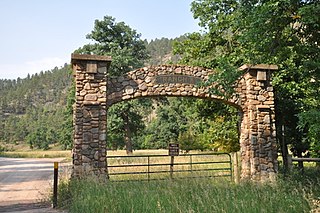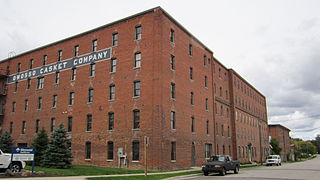
The Eastlake movement was a nineteenth-century architectural and household design reform movement started by British architect and writer Charles Eastlake (1836–1906). The movement is generally considered part of the late Victorian period in terms of broad antique furniture designations. In architecture the Eastlake style or Eastlake architecture is part of the Queen Anne style of Victorian architecture.

Hubbell Trading Post National Historic Site is a historic site on Highway 191, north of Chambers, with an exhibit center in Ganado, Arizona. It is considered a meeting ground of two cultures between the Navajo and the settlers who came to the area to trade.

The Tangier American Legation is a building in the medina of Tangier, Morocco. The first American public property outside the United States, it commemorates the historic cultural and diplomatic relations between the United States and the Kingdom of Morocco. It is now officially called the Tangier American Legation Institute for Moroccan Studies, and is a cultural center, museum, and a research library, concentrating on Arabic language studies.

Sam Maloof was a furniture designer and woodworker, the first craftsman to receive a MacArthur fellowship. Maloof's work is in the collections of several major American museums, including the Metropolitan Museum of Art, the Los Angeles County Museum of Art, the Philadelphia Museum of Art, and the Smithsonian American Art Museum. He was described by The New York Times as "a central figure in the postwar American crafts movement".

The Mark Twain Boyhood Home & Museum is located on 206-208 Hill Street, Hannibal, Missouri, on the west bank of the Mississippi River in the United States. It was the home of Samuel Langhorne Clemens, better known as author Mark Twain, from 1844 to 1853. Clemens found the inspiration for many of his stories, including the white picket fence, while living here. It has been open to the public as a museum since 1912, and was designated a National Historic Landmark on December 29, 1962. It is located in the Mark Twain Historic District.

The Ellwood House was built as a private home by barbed wire entrepreneur Isaac Ellwood in 1879. It is located on First Street in DeKalb, Illinois, United States, in DeKalb County. The Victorian style home, designed by George O. Garnsey, underwent remodeling in 1898-1899 and 1911. The house was originally part of 1,000 acres (4 km²) which included a large stable complex known as "Ellwood Green." Isaac Ellwood lived here until 1910 when he passed the estate to his son, Perry Ellwood.

Wharton Esherick Studio, now housing the Wharton Esherick Museum, was the studio of the craftsman-artist Wharton Esherick (1887–1970), in Malvern, Pennsylvania. The Studio was built between 1926 and 1966, reflecting Esherick's evolving sculptural style—from Arts and Crafts, through German Expressionism, ending with the free form Modernist curves that marked his later work.

The Old Stone House is the oldest unchanged building in Washington, D.C., United States. The house is also Washington's last pre-revolutionary colonial building on its original foundation. Built in 1765, Old Stone House is located at 3051 M Street, Northwest in the Georgetown neighborhood. Sentimental local folklore preserved the Old Stone House from being demolished, unlike many colonial homes in the area that were replaced by redevelopment.

The Thomas Gould Jr. House is a historic house located at 402 Lynn Drive in Ventura, California. Architect Henry Mather Greene designed the American Craftsman style California bungalow, which was built in 1924. The house is considered one of the best examples of Henry Greene's independent work; most of his other designs were created alongside his brother Charles as Greene & Greene. The two-story house has a wood frame and redwood siding and window casings. The gable roof features truncated ends and a small gable on the front side which resembles a dormer. The house's interior decorations include ceiling moldings, a leaded glass china cabinet, and a carved mirror, the latter being the only piece of furniture designed by Greene himself.

This is a list of the National Register of Historic Places listings in Sacramento County, California.

The George Nakashima House, Studio and Workshop is a historic artist's compound at 1847 and 1858 Aquetong Rd. in Solebury Township, Bucks County, Pennsylvania. The compound consists of houses and studio buildings designed and built by artist George Nakashima (1905-1990), which served as family homes and as his studio space. The studio-related buildings are open to the public for tours; the houses of the compound continue to serve as residences of the Nakashima family. In April 2014 it was also designated a National Historic Landmark. The site was listed on the World Monument Fund's 2014 Endangered Sites Watchlist.

The Buckner Homestead Historic District, near Stehekin, Washington in Lake Chelan National Recreation Area incorporates a group of structures relating to the theme of early settlement in the Lake Chelan area. Representing a time period of over six decades, from 1889 to the 1950s, the district comprises 15 buildings, landscape structures and ruins, and over 50 acres (200,000 m2) of land planted in orchard and criss-crossed by hand-dug irrigation ditches. The oldest building on the farm is a cabin built in 1889. The Buckner family bought the farm in 1910 and remained there until 1970, when the property was sold to the National Park Service. The Buckner Cabin was listed on the National Register of Historic Places in 1974. The rest of the Buckner farm became a historic district in 1989. Today, the National Park Service maintains the Buckner homestead and farm as an interpretive center to give visitors a glimpse at pioneer farm life in the Stehekin Valley.

Ranch A, near Beulah, Wyoming, was built as a vacation retreat for newspaper publisher Moses Annenberg. The original log ranch structures in Sand Creek Canyon were designed in the rustic style by architect Ray Ewing. The principal building, a large log lodge, was built in 1932. Other buildings constructed at the time included a garage with an upstairs apartment, a barn, a hydroelectric power plant, stone entrance arches and a pump house. The lodge was furnished with Western furniture and light fixtures made by noted designer Thomas C. Molesworth. Many of these furnishings, among the first of Molesworth's career, are now the property of the state of Wyoming and are in the Wyoming State Museum.

The Renwick Building is located in downtown Davenport, Iowa, United States. It has been listed on the National Register of Historic Places since 1983, and on the Davenport Register of Historic Properties since 2000. In 2020 it was included as a contributing property in the Davenport Downtown Commercial Historic District. It is known locally for the large painted sign on the north side of the building depicting the Bix 7 Road Race.

The David L. Shirk Ranch is a historic ranch located in the Guano Valley of eastern Lake County, Oregon, United States. The ranch was originally homesteaded in 1881. It was purchased by David L. Shirk in 1883. He operated the ranch until 1914. The property was acquired by the United States Government in 1942. The ranch is now administered by the Bureau of Land Management. The remaining historic ranch buildings are listed on the National Register of Historic Places.

The Old Mill House is an historic property located in Le Claire, Iowa, United States. The Greek Revival style residence has been listed on the National Register of Historic Places since 1979. The property is part of the Houses of Mississippi River Men Thematic Resource, which covers the homes of men from LeClaire who worked on the Mississippi River as riverboat captains, pilots, builders and owners. It is also a contributing property in the Cody Road Historic District.

The Arizona Rancho, also known as the Higgins House, Brunswick Hotel and Arizona Hotel, is a former hotel in Holbrook, Arizona. It was originally built between 1881 and 1883 as a residence, the expanded as a boarding house, a hotel, and finally as a motel. The original structure is thought to be the oldest extant structure in Holbrook.

Sams Plantation Complex Tabby Ruins is a historic plantation complex and archaeological site located at Frogmore, Beaufort County, South Carolina. The site, possibly built upon and occupied well before 1783. It includes the ruins and/or archaeological remains of at least 12 tabby structures. They include the main plantation house, a rectangular enclosure consisting of tabby walls, a large tabby kitchen, and five tabby slave quarters. Also on the property were a variety of tabby dependencies including a barn/stable, a smoke house or blade house, a well/dairy house, and a well. The property also includes the Sams family cemetery and Episcopal chapel enclosed by high tabby walls. Other structures include possibly an overseer's house, a granary/mill, and a tabby cotton house. During and subsequent to the American Civil War the Sams Tabby Complex was occupied by freedman. Following the Civil War the plantation house was destroyed by hurricanes.

The Lyman Woodard Furniture and Casket Company Building is a former factory building located at 219-222 South Elm Street in Owosso, Michigan. It was listed on the National Register of Historic Places in 1980.
Alfreda Louise Maloof was a teacher, a Navy WAVE and business manager and wife of Sam Maloof. Maloof co-founded her husband's woodworking business, Sam Maloof Woodworker, Inc. "Alfreda sustained and nourished the family, the business, the possibilities of making a living and a life from art and craft." Maloof was a founding member of the Sam and Alfreda Maloof Foundation for Arts and Crafts in 1994.























